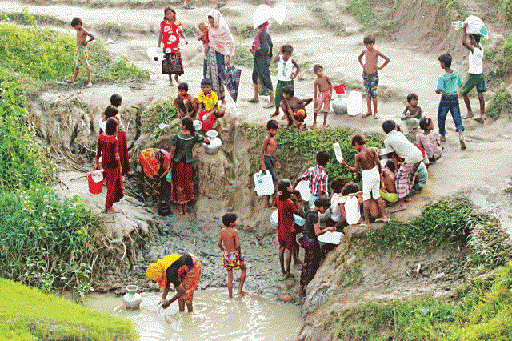Rohingya fleeing from Myanmar suffers from drinking water crisis Women and children are collecting water from the canal adjacent to the temporary Rohingya camp in Hiokong Putibnia area of Teknaf. The photo was taken on Saturday afternoon l Prothom-alo
Najahat and Monirira Kumbha water kalas Almost three kilometers away, they brought water from the aluminum pots and brought water from high hills. Due to the passage by the mountain side, the pots were pulled down a little bit. Talking to them at that moment.
Both of them are aged eight to ten years old. Their house by camping with blue plastic plates in Putibuniya hill slopes. They have been here since the last 12 days. Although there is no room for grilling, there is still no provision for drinking water. This new Rohingya shelter in Teknaf's Hoeking union has not yet installed the tube well. So they are about to go to the nearby village about three kilometers away to get pure water from the tube well.
It was found on Saturday that the intense crisis of pure drinking water in new Rohingya shelters was found. There is also a crisis of cultural activities, cooking or bathing water. Millions of people, but pure water was not available for them. Due to the use of contaminated water the children suffer from diarrhea and abdominal aches. There is also no toilet facility. Under the open sky, bushes or hilly forests have to meet their natural needs.
As Teknaf and Ukhia administration, about 1.5 lakh new teknafs and 4.5 lakhs in Ukhia - about six lakh new Rohingyas enter. 60 percent of them children. About 80 percent of them suffer from fever and water borne diseases. Cox's Bazar civil surgeon Abdus Salam said 32 medical camps are working in Rohingya shelters. Every day more than 1500 patients are given primary treatment in these camps.
Waikung Union Parishad chairman Nur Ahmed Anwar said there is a severe crisis of water without rain. The water crisis has increased so many people are coming. Rohingyas are wailing for water.
This new shelter center has been developed at the end of the north end of Teknaf at Puthibunia Hills by the BGB. Now the number of shelters is around one and a half million. The horrific scene was seen in a few inside the shelter center. A stream flowed down on the hills, and turned down the slope as an inlet, down the slope. When it came to the plains, it was like a narrow canal. There are also water. Maybe he was once cleansing the water. But now the madda From the various places of the passage, hundreds of children and males and females are taking plastic bottles, buckets, and cottages in the mud-free water.
Atikur Rahman's wife Monoara Begum filled the bucket from here. Myanmar's Maungdaw Kewar Bill had their home. Two days after Eid, six people, including four children, were brought to the shelter center. Asked what to do in this dinghy water, he said, it will work to wash. But after washing the rice in this water, Balu tastes to eat cooked rice. But there is no way out.
Cascading toilet like water in the shelter center. The children are leaving the excrement at the bank of the canal. The elderly are going to the hillside-bush 65-year-old Ruhul Amin from Tulatuli village of Maungdaw said that there was never such an experience. He is quite a handful of people. There were about four acres of land in the house, two wooden houses There were good bathrooms and toilets. Now it has come to the bottom of the open sky. In this case, the problem of women is more. Temporary shelf surrounded by 10-15 plastic sheets in one row. They are now ineligible for people's pressure.
Teknaf-2 BGB Deputy Commander Major Shariful Islam Jummadar said that the new shelters have not yet been made available for water and sanitation. Some NGOs are providing emergency water, but it is very little compared to the requirement.
Apart from this big shelter station in Putubaniya, many medium and small Rohingya slums have been developed in Teknaf. Meanwhile, the slums of Nature Park are quite big. The population here is estimated at 50 thousand. Another slum has been made in Baharchhara. The small slums have been built in the areas of Jadimura, Mokini, Dumdemiya. And there is a lot of zubargharas on one side of the road. These small-large slums-dwellers of Juppa have no advantage of drinking water or toilet.

It has been found that, in the new shelter center of Ukhia, there is no provision of water for the drinking water and toilets. Here the number of people is more than one and a half million. Apart from this, slums of five to twenty thousand people have been developed in the areas of Tengkhali, Bagguna, South Bagguna, Makkah bills and Morcha.
Teknaf and Ukhaiah government registered and unregistered old shelters have facilities for drinking water and toilets. However, these shelters are also under pressure of additional people, so these advantages have come under crisis.
luar biasa
Downvoting a post can decrease pending rewards and make it less visible. Common reasons:
Submit